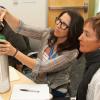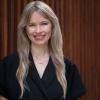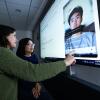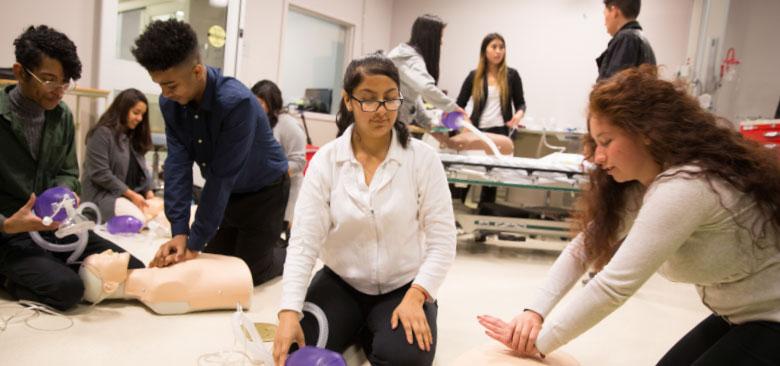
Students from Oakland Unified School District work on their resuscitation skills in the simulation lab (photos by Elisabeth Fall).
You Belong Here: Changing the Makeup of the Health Care Workforce
In the last few years, the UC San Francisco School of Nursing has instituted a number of innovative programs aimed at reducing barriers to health care careers for people from underserved communities. The programs recognize and hope to help address a glaring factor in health disparities and in the health of the nation.
That is: despite the fact that by 2060, 56 percent of the population will be made up of groups currently considered racial and ethnic minorities, public health researchers estimate that people of color represent only 10 percent of the health care workforce. Many experts believe – and studies have shown – that this under-representation adversely affects minority health outcomes. In fact, in its 2003 report “Unequal Treatment: Confronting Racial and Ethnic Disparities in Health Care,” the Institute of Medicine recommended increasing the racial and ethnic diversity of the health professions, noting that a more diverse workforce could increase cultural and social competencies that can improve health care and, potentially, outcomes.
Unfortunately, in the 14 years since, the health care workforce has been slow to diversify, and few question the need for broad-based national programs and policies to create a scaffolding for change. Yet the School’s multipronged approach to the problem is tacit recognition that change has to begin somewhere, there are many opportune starting points, and each minority student who successfully enters and navigates an educational program and launches a career in health care can have a ripple effect that brings more people of color into the professions.
Health Pathways Project Introduces Students to Health Careers
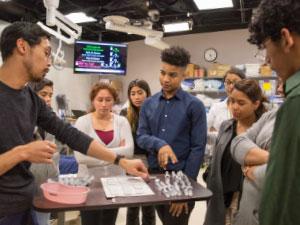 Oakland Unified School District students in the UCSF Kanbar Center for Simulation and Clinical Skills Education On a sunny day in May 2017, at the UCSF Kanbar Center for Simulation and Clinical Skills Education, a teen struggled to pop the cap off a syringe of epinephrine while another performed chest compressions on their “patient,” who lay moribund on a gurney. Another young man, his face scrunched in concentration, manipulated the manual resuscitator, pushing life-giving oxygen into the patient’s lungs.
Oakland Unified School District students in the UCSF Kanbar Center for Simulation and Clinical Skills Education On a sunny day in May 2017, at the UCSF Kanbar Center for Simulation and Clinical Skills Education, a teen struggled to pop the cap off a syringe of epinephrine while another performed chest compressions on their “patient,” who lay moribund on a gurney. Another young man, his face scrunched in concentration, manipulated the manual resuscitator, pushing life-giving oxygen into the patient’s lungs.
The drug was duly administered, and a few moments later the instructor, who’d been watching, arms crossed, from the sidelines, called, “OK, you have a heartbeat. Stop the compressions. You saved his life. Good job.” The trio of teenagers relaxed, grinning in the afterglow of a job well done.
The young people were part of a group of students from Oakland Unified School District (OUSD) – and the adrenaline-filled culmination of weeks of training was part of the School’s Health Pathways Project, which introduces high school students to health careers by immersing them in experiences like this one.
Funded by a grant from The Atlantic Philanthropies, the project recruits high school juniors and seniors from OUSD to participate in training modules that prepare them for externship opportunities – a way to explore health professions from the inside. Placements inside health centers and hospitals allow young participants to shadow nurses, physicians and other clinicians and staff, exposing them to the roles various providers play in the health care team and to the decision-making skills required in real health care environments.
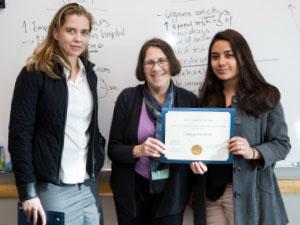 From left: Linda Stephan, Naomi Schapiro and Oakland Unified School District student Cathya Mendoza Students are also trained to be standardized patients – individuals who portray patients with medical problems in simulated encounters with clinicians in training. In addition to acquiring acting skills and “insider” clinical knowledge of diseases and disorders and how clinicians work, students learn leadership skills and how to provide essential feedback to clinicians in training – skills that can benefit them in any profession they ultimately choose to pursue.
From left: Linda Stephan, Naomi Schapiro and Oakland Unified School District student Cathya Mendoza Students are also trained to be standardized patients – individuals who portray patients with medical problems in simulated encounters with clinicians in training. In addition to acquiring acting skills and “insider” clinical knowledge of diseases and disorders and how clinicians work, students learn leadership skills and how to provide essential feedback to clinicians in training – skills that can benefit them in any profession they ultimately choose to pursue.
While there are other programs around the country that train high school students to act as standardized patients, Health Pathways is unusual in its focus on underserved youth, says Naomi Schapiro, professor of Family Health Care Nursing, who directs the project with assistant clinical professors Linda Stephan and Jayme Mejia. “Most [of the programs] look for high-performing students who are already thinking about medical or nursing school,” she says. “We wanted to look at average students and those at risk of dropping out to try to bring them into health careers at every level.”
Mejia, who comes from a family of immigrants and grew up in San Francisco’s Mission District, has worked in Native American Health Center’s School-Based Health Centers in Oakland for the past nine years and helped develop the Health Pathways training program. Her own passion for caring came from personal experiences – positive and negative – with the health care system while growing up. She says, “I was going to go to law school to be a human rights lawyer, but then I realized that nursing was perfect because you get the hands-on and advocacy skills.”
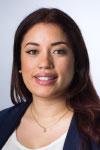 Jayme Mejia Mejia aims to pass the idea of health care as advocacy on to the students. She notes that the idea of helping your community can be a strong motivator for young people exploring health careers. “I did a lot of one-on-one mentorship, making connections with the youth and helping them understand how this was relevant to them and their families,” she says. “I wanted to help them understand that this enables you to empower your family, and as a clinician, you will empower your patients.”
Jayme Mejia Mejia aims to pass the idea of health care as advocacy on to the students. She notes that the idea of helping your community can be a strong motivator for young people exploring health careers. “I did a lot of one-on-one mentorship, making connections with the youth and helping them understand how this was relevant to them and their families,” she says. “I wanted to help them understand that this enables you to empower your family, and as a clinician, you will empower your patients.”
Finding New Ways to Get People of Color into Health Care Professions
Assistant Professor of Family Health Care Nursing Monica McLemore – a nationally recognized researcher and advocate in the area of women’s reproductive heath and justice – is leading or co-leading a number of other programs associated with the School that help people of color pursue education and careers in health care.
“I’ve so often been the only [person of color], and that’s unethical,” she says of her career as a nurse-scientist and educator.
On one of the projects, McLemore provides educational and research support to the East Bay Community Birth Support Project, a collaboration between UCSF and a pair of community organizations, the Birth Justice Project and the Black Women Birthing Justice collective. Project staff have trained low-income and previously incarcerated women to become birth doulas – companions who offer nonclinical support to women in childbirth. McLemore’s research has found such programs have successfully increased empowerment and confidence among trainees, and may have helped prevent recidivism among the program’s previously incarcerated cohort; none of the trainees had returned to jail at the time of McLemore’s assessment. Six of the original participants have also been trained to provide cognitive behavioral support via a modularized, web-based intervention to highly stressed women for a randomized clinical trial that’s part of the UCSF Preterm Birth Initiative.
“It’s exciting work,” says McLemore. “We’re partnering with collaborators from UCLA who developed [the intervention], and it’s providing the doulas not only with a continued source of income, but also an expansion of their skill set.”
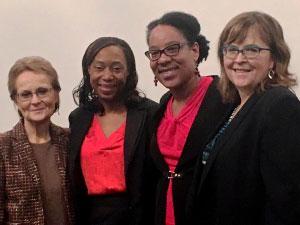 From left: Sandra Weiss, Gina Brown, Monica McLemore, Audrey Lyndon McLemore is also an investigator for SF BUILD, a National Institutes of Health (NIH)-funded project aimed at increasing the diversity of the biomedical research workforce by creating supportive environments for students and faculty from different backgrounds. Through a partnership between the School and San Francisco State University, SF BUILD provides training, mentorship and financial support to help students of color pursue graduate education and, ultimately, careers in the biomedical sciences.
From left: Sandra Weiss, Gina Brown, Monica McLemore, Audrey Lyndon McLemore is also an investigator for SF BUILD, a National Institutes of Health (NIH)-funded project aimed at increasing the diversity of the biomedical research workforce by creating supportive environments for students and faculty from different backgrounds. Through a partnership between the School and San Francisco State University, SF BUILD provides training, mentorship and financial support to help students of color pursue graduate education and, ultimately, careers in the biomedical sciences.
Now, along with Chair of Family Health Care Nursing Audrey Lyndon, McLemore has helped develop a proposal to create relationships between the School and historically black colleges and universities (HBCUs) to help HBCU nursing students prepare for graduate nursing careers.
HBCUs represent a missed opportunity to channel talented people of color into health professions, says McLemore. She notes that when the 1910 publication of the seminal Flexner Report on Medical Education in the United States and Canada resulted in the closure of five of the seven medical schools at HBCUs, it drastically narrowed one pipeline to health care professions for African Americans and interrupted the development of an academic culture in the health professions for people of color. McLemore is among those who argue the resulting discrimination and segregation have reached across the 20th century into the 21st. “It’s one of many reasons we don’t have an adequate health care workforce of people of color,” says McLemore.
Fruitful discussions between McLemore, Lyndon, then-Interim Dean Sandra Weiss and Gina Brown, dean of Nursing and Allied Health Sciences at Howard University (a historically black university in Washington, DC) led to several plans to bring Howard students together with peers and potential mentors at the graduate nursing level who might help them forge a path into nursing research and education.
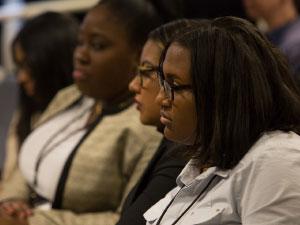 Howard University students attend the Nursing Leaders of Tomorrow Conference at UCSF. And, in October, the School hosted the Nursing Leaders of Tomorrow Conference, which brought students from Howard and across California to meet with nurse practitioners, clinical nurse specialists and specialty faculty to talk about nursing career paths, forge connections and receive advice and mentoring.
Howard University students attend the Nursing Leaders of Tomorrow Conference at UCSF. And, in October, the School hosted the Nursing Leaders of Tomorrow Conference, which brought students from Howard and across California to meet with nurse practitioners, clinical nurse specialists and specialty faculty to talk about nursing career paths, forge connections and receive advice and mentoring.
Graduate nursing students gave the conference attendees a firsthand look at the realities of advanced study. Faculty and student researchers led discussions of health disparities research, culturally responsive care and other issues surrounding health care among underserved communities. In addition, says McLemore, a group of nursing students from Howard plans to come to UCSF next year for more in-depth training and mentorship in developing research and teaching skills.
The bottom line for McLemore is reducing disparities and improving health for communities of color. “Diversification of the health care workforce is important because it has a significant impact on outcomes,” she says. “[Racism] seeps into how decisions get made, how involved or engaged people are in their own care and around how interventions are applied or not.”
Supporting First-Gen-to-College Students
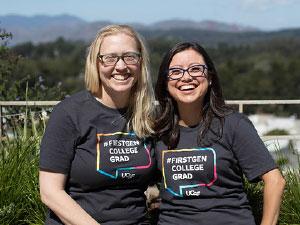 Laura Wagner (left) with mentee, Adult-Gerontology Primary Care Nurse Practitioner student Claudia Barrera Getting people from underserved communities into training programs for the health professions is only one part of the battle. Keeping them there is another significant challenge. The School’s FirstGenRN project aims to support students who are the first in their families to go to college (known by the acronym FG2C).
Laura Wagner (left) with mentee, Adult-Gerontology Primary Care Nurse Practitioner student Claudia Barrera Getting people from underserved communities into training programs for the health professions is only one part of the battle. Keeping them there is another significant challenge. The School’s FirstGenRN project aims to support students who are the first in their families to go to college (known by the acronym FG2C).
“They’re often referred to as the ‘invisible minority,’” says Associate Professor of Community Health Systems Laura Wagner, who directs the project. About 25 percent of all UCSF students identify as FG2C, and 50 percent are the first in their families to attend a graduate or professional school, she says. Consequently, they often face special challenges. They are more likely to be members of under-represented minority groups or come from disadvantaged socioeconomic backgrounds; they have higher attrition rates and take a longer time to graduate than their peers.
The FirstGenRN project, which is supported by UCSF Innovations Funding for Education, is attempting to address the challenges faced by FG2C students. Wagner – along with research assistant and Master’s Entry Program in Nursing student Denisse Porter – is designing workshops tailored to the needs of FG2C students. Topics include building a career action plan, communication with mentors and advisors, financial management, scientific writing and more. Both Wagner and Porter were the first in their families to attend college.
Wagner based her proposal for the project on her own experiences as a student and what she’s observed and heard from the students she’s mentored at the School. “My challenges were similar [to the students’]: financial, family, struggles with writing, taking constructive criticism,” she says. “There were also social challenges like, How do you interact at a party? How do you communicate with others from different social classes?”
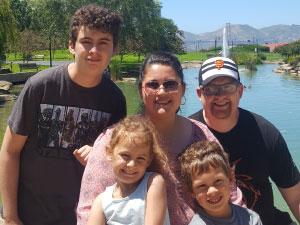 Denisse Porter with her family The difficulties are exacerbated by the lack of mentors with similar experiences. “You have to seek out mentors,” Porter says. “It’s hard when you’re from an underserved or marginalized community because you often don’t have anyone to look up to or get advice from.” Porter found a mentor when a friend in the School’s PhD degree program introduced her to Wagner, who was looking for someone to help design and implement the FirstGenRN project.
Denisse Porter with her family The difficulties are exacerbated by the lack of mentors with similar experiences. “You have to seek out mentors,” Porter says. “It’s hard when you’re from an underserved or marginalized community because you often don’t have anyone to look up to or get advice from.” Porter found a mentor when a friend in the School’s PhD degree program introduced her to Wagner, who was looking for someone to help design and implement the FirstGenRN project.
Porter brings an important perspective to the project. Her parents were immigrants to the United States, and neither completed high school. The family immigrated when Porter was 5, and when she graduated high school, despite having a good academic record, she found herself unable to begin college right away; as an undocumented immigrant, she didn’t qualify for financial aid or scholarships.
Such struggles mean that students from underserved communities often have a longer path to graduate education, so it takes longer before they are able to secure paying jobs in their chosen fields. The difficulty is compounded for those who, like Porter, already have young children when they are ready to begin their graduate studies – so the pressures and time demands make it more difficult to complete their education.
These are issues that are often hidden to faculty until a student runs into difficulty. That’s too late in the game, says Wagner. “If we can identify these things more upstream, we could do a better job of supporting these students.”
Thus, part of the FirstGenRN program plan is to hold faculty development workshops with “mentor modules” in collaboration with the School’s Diversity in Action (DIVA) Committee that will help faculty identify FG2C students early and to understand the needs of the FG2C community.
Wagner has also started a FirstGenRN Facebook group to help build community and provide support for the growing number of nurses who are the first in their family to attend college.
At the conclusion of the project’s first year, Wagner will use several evaluation tools to determine whether it has had any impact on FG2C students’ perceptions, motivation and ability to succeed in a challenging academic environment like UCSF. If it is successful, she hopes the program can expand and serve as a model for other programs and schools.
Giving Students a Sense of Belonging
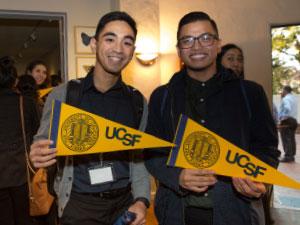 A thread that runs through each of these programs is the idea that providing a sense of belonging is key to getting and keeping people from underserved or marginalized communities in health care professions. It’s a feeling that is missingn all too often.
A thread that runs through each of these programs is the idea that providing a sense of belonging is key to getting and keeping people from underserved or marginalized communities in health care professions. It’s a feeling that is missingn all too often.
As Mejia puts it, “We want to plant a seed that says, ‘You belong here.’”

